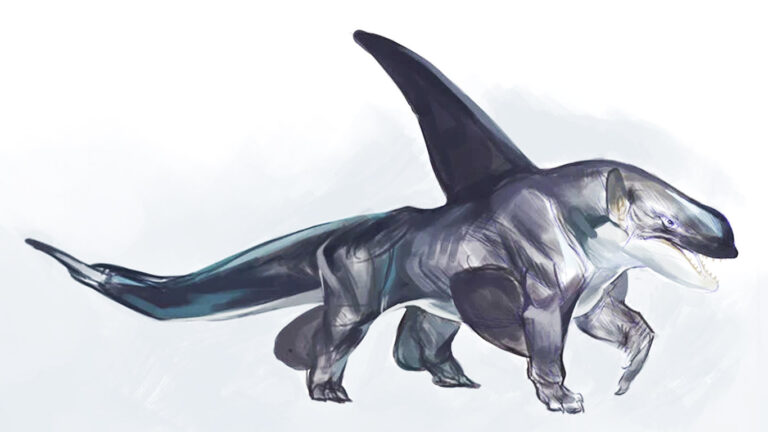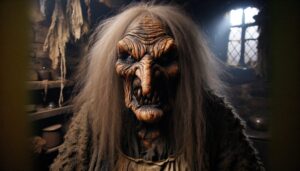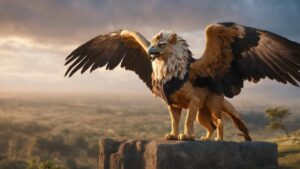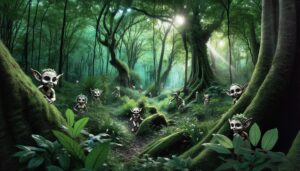Table of Contents
Akhlut is a creature from Inuit mythology, particularly among the indigenous peoples of the Arctic regions, including the Inupiat and Yupik cultures. It is often described as a mythical sea creature or a shape-shifting creature with the ability to transform between an orca (killer whale) and a wolf.
The Akhlut is said to possess the strength and speed of both a killer whale and a wolf, making it a formidable and dangerous creature in Inuit folklore. It is known for hunting seals and other marine animals in the water, as well as land-based prey when in its wolf form. This shape-shifting ability and its status as a powerful and mysterious being make the Akhlut a prominent figure in Inuit mythology and stories.
Origin
The origin of the Akhlut creature can be traced back to the mythology and oral traditions of the indigenous peoples of the Arctic, particularly the Inuit, Inupiat, and Yupik cultures. These cultures have inhabited the Arctic regions of North America for thousands of years, and their mythologies and stories have been passed down through generations orally.
In Inuit mythology, the Akhlut is one of many supernatural beings that are believed to inhabit the natural world. These mythological beings often serve as a way for the Inuit people to explain natural phenomena, understand the world around them, and pass down cultural and moral lessons through storytelling.
The Akhlut, with its shape-shifting abilities and its connection to both the sea (killer whale) and land (wolf), likely represents the close relationship that the Inuit people historically had with the harsh Arctic environment and its wildlife. The creature embodies the mystery and power of the natural world, as well as the idea that animals and spirits could possess transformative qualities.
Physical Description
The physical description of the Akhlut can vary somewhat in different versions of Inuit mythology and storytelling, but it generally combines features of both a killer whale (orca) and a wolf due to its shape-shifting nature. General depiction of the Akhlut:
Orca (Killer Whale) Form:
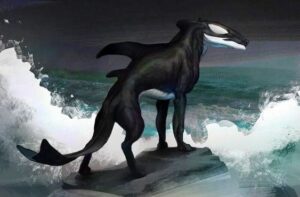
The upper part of its body resembles that of a killer whale, with a sleek and streamlined appearance.
It typically has a dark-colored back and sides, often black or deep blue.
The lower part of its body, including its belly, is typically white or light-colored.
The Akhlut’s head in its orca form resembles that of a killer whale, with a prominent dorsal fin on its back.
It possesses the powerful tail flukes of a killer whale, which it uses for swimming and hunting in the water.
Wolf Form:

In its wolf form, the Akhlut takes on the appearance of a large and fearsome wolf.
It may have fur that is dark in color, such as black or gray, to match its orca form’s coloring.
The Akhlut’s eyes are often described as glowing with an eerie or supernatural light.
Its size can vary but is typically larger than a normal wolf, reflecting its strength and power.
The ability to transform between these two forms is a key characteristic of the Akhlut. This shape-shifting quality allows it to move seamlessly between the sea and the land, making it a formidable and elusive creature in Inuit mythology.
Personality
In Inuit mythology and storytelling, the personality and behavior of the Akhlut can vary, but some common traits and characteristics are associated with this mythical creature.These traits can be subject to variations in different accounts and stories:
Ferocious and Predatory: The Akhlut is often depicted as a fierce and predatory creature. In its orca form, it is a skilled hunter of marine animals, such as seals and fish. In its wolf form, it is equally adept at hunting land-based prey. Its predatory nature makes it a formidable and dangerous being.
Cunning and Elusive: The Akhlut is considered to be a clever and elusive creature. It uses its shape-shifting abilities to its advantage, allowing it to stalk and surprise its prey both in the sea and on land. This cunning nature contributes to its reputation as a mysterious and powerful being.
Protector or Guardian: In some stories, the Akhlut may be seen as a protector or guardian figure, especially by those who respect and honor the natural world. It may be associated with the idea of maintaining the balance of nature and ensuring the well-being of the ecosystem it inhabits.
Symbol of Transformation: The Akhlut’s shape-shifting ability symbolizes transformation and adaptability. It serves as a reminder of the interconnectedness of different aspects of the natural world and the fluidity of existence.
Mysterious and Enigmatic: The Akhlut is often shrouded in mystery and mystique. Its supernatural abilities and the awe it inspires in those who encounter it contribute to its enigmatic nature.
Reflecting Cultural Values: The personality and role of the Akhlut in stories can also reflect the values and beliefs of the Inuit culture. It may serve as a metaphorical representation of the challenges and lessons inherent in their environment.
The Akhlut is known for its special abilities, which are a central part of its mythology in Inuit culture. These abilities are typically associated with its shape-shifting nature and its dual identity as both a killer whale (orca) and a wolf. Special abilities often attributed to the Akhlut:
Shape-Shifting: The most notable ability of the Akhlut is its power to transform between two distinct forms—the orca form and the wolf form. This shape-shifting capability allows it to move seamlessly between the sea and the land, making it a formidable and elusive predator.
Superhuman Strength: In both its orca and wolf forms, the Akhlut is believed to possess superhuman strength, which makes it an exceptionally powerful and dangerous creature. This strength aids it in hunting and overpowering prey.
Speed and Agility: The Akhlut is known for its remarkable speed and agility. In its orca form, it is a swift swimmer, capable of quickly chasing down marine prey. In its wolf form, it can run with great speed and agility on land.
Hunting Skills: The Akhlut is a skilled and efficient hunter, using its abilities in both forms to hunt for seals, fish, and other marine animals in the water, as well as land-based prey when in its wolf form.
Elusiveness: The Akhlut is often described as an elusive and cunning creature. Its ability to change forms makes it difficult to track and capture, contributing to its reputation as a mysterious and hard-to-catch being.
Guardian or Protector: In some interpretations, the Akhlut is seen as a guardian or protector of the natural world, particularly the marine environment. It may play a role in maintaining the balance of nature and ensuring the well-being of the ecosystem it inhabits.
Symbol of Transformation: Beyond its physical abilities, the Akhlut serves as a symbol of transformation and adaptability. Its existence highlights the interconnectedness of different aspects of the natural world and the fluidity of life.
These special abilities are integral to the mythology and stories surrounding the Akhlut in Inuit culture. They emphasize the creature’s dual nature, its strength, and its adaptability in navigating the challenging Arctic environment.
In Modern Usage and Symbolism
In modern usage and symbolism, the Akhlut from Inuit mythology is not as widely recognized or referenced as some other mythical creatures from different cultures. However, it still holds cultural and symbolic significance, especially within indigenous communities in the Arctic regions and among those interested in native cultures and mythology. Akhlut may be interpreted and symbolized in contemporary contexts:
Environmental Conservation: The Akhlut, as a symbol of the natural world and its interconnectedness, can be used to promote environmental conservation and awareness. It may represent the need to protect and preserve the fragile Arctic ecosystem, including the marine life it embodies.
Adaptability and Resilience: The shape-shifting ability of the Akhlut can symbolize adaptability and resilience in the face of changing circumstances. In a world dealing with climate change and evolving challenges, the Akhlut’s transformation may serve as a metaphor for the need to adapt and find creative solutions.
Cultural Identity: Within indigenous communities, the Akhlut may continue to hold cultural significance as a representation of traditional beliefs and storytelling. It can be a symbol of cultural identity and heritage, reminding people of their connection to their ancestral mythology.
Art and Literature: Contemporary artists, writers, and storytellers may incorporate the Akhlut into their works as a means of exploring themes related to transformation, duality, and the relationship between humans and the natural world.
Conservation Efforts: In some regions, efforts may be made to protect and conserve killer whales and wolves, which are real-life counterparts to the Akhlut’s two forms. These efforts may draw inspiration from the mythical creature as a symbol of the importance of these animals in the ecosystem.
Symbol of Mystery and Wonder: The Akhlut’s mystical and enigmatic nature can continue to captivate imaginations and inspire a sense of wonder. It may be used in modern contexts to evoke curiosity and fascination with the natural world.
Ralated and similar creatures
In various cultures and mythologies around the world, there are creatures that share certain similarities with the Akhlut, particularly in their shape-shifting abilities or their connection to both land and water. Here are a few related or similar mythical beings from different cultural backgrounds:
Selkie (Celtic and Norse Mythology): Selkies are creatures from Celtic and Norse mythology that can transform from seal to human form by shedding their seal skins. In their human form, they can live on land and interact with humans, but they are bound to return to the sea when they reclaim their seal skins.
Kelpie (Scottish Folklore): The Kelpie is a water spirit from Scottish folklore that often takes the form of a horse. It is known for luring travelers, especially children, to ride on its back and then dragging them into the water to devour them.
Skinwalker (Navajo and Ute Mythology): In Navajo and Ute mythology, a skinwalker is a witch or sorcerer who has the ability to shape-shift into various animals, including wolves, coyotes, and other creatures. They are believed to use this power for malevolent purposes.
Kitsune (Japanese Folklore): Kitsune are fox spirits in Japanese folklore known for their shape-shifting abilities. They can transform into human form and often possess supernatural powers and wisdom.
Swan Maiden (Various Cultures): Swan maidens are mythical beings found in various cultures, including Celtic, Norse, and Slavic. They are often swans who can change into beautiful women. In many stories, their swan feathers are the source of their power, and if their feathers are stolen, they are bound to the human world.
Nix or Neck (Scandinavian Folklore): The Nix is a water spirit in Scandinavian folklore known for its shape-shifting abilities and the ability to appear as a beautiful human or as a water creature. It is often associated with lakes and rivers.
Encantado (Amazonian Folklore): In Amazonian folklore, the Encantado is a shape-shifting river dolphin that can transform into a handsome human. They are often seen as seductive and alluring, capable of enchanting and luring people away.
FAQ
What is an Akhlut?
An Akhlut is a creature from Inuit mythology that combines the characteristics of a wolf and an orca.
Where does the Akhlut come from?
It originates from the folklore of the Inuit people of the Arctic regions.
What does an Akhlut look like?
It looks like a wolf with the body of an orca, capable of moving on land and in water.
Is the Akhlut a deity or a spirit?
In myths, it's often considered a powerful spirit or a supernatural being.
Can the Akhlut transform?
Legend suggests it can transform from a wolf to an orca, especially near water.
Are Akhluts dangerous in folklore?
Yes, they are typically depicted as fierce and dangerous creatures in mythology.
Does the Akhlut have special powers?
Mythologically, it’s believed to have powers related to both the wolf and the orca, such as great strength and swimming ability.
What does the Akhlut symbolize?
It often symbolizes the duality of nature and the interconnectedness of land and sea.
Do Akhluts interact with humans?
In stories, they sometimes interact with humans, often as ominous figures.
Where do Akhluts live?
Akhluts are said to inhabit the coastal waters and lands of the Arctic.
How do you pronounce 'Akhlut'?
It's generally pronounced as 'AHK-loot'.
Are there any rituals associated with the Akhlut?
Specific rituals are not commonly known, as the Akhlut is more of a mythological creature than a deity.
Has the Akhlut been featured in modern media?
Occasionally, the Akhlut appears in books, games, and art, drawing from Inuit myths.
What lessons do we learn from Akhlut stories?
Akhlut tales often teach respect for the forces of nature and the dangers of the wild.
